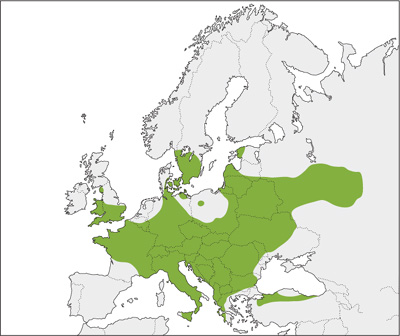
Muscardinus avellanarius
Common Dormouse, also known as Hazel Dormouse, is the same size as a House Mouse. It has a short snout and long whiskers, large, dark eyes, and hairy ears. Its body is compact, 6 cm long, and it weighs 15–40 g, a little more in autumn. It is reddish or orange-brown above and yellowish brown below with a white throat and chest. The tail is 5.5–7.5 cm long. The long hair gives the animals something of a bushy appearance.
Common Dormouse lives in deciduous and mixed woodland with thick and varied underbrush but may also be found in open landscapes with bushes, or in gardens and parks and also occasionally in buildings. The dormice prefer locations where they can avoid being on the ground.
Common Dormice are nocturnal; during the day they lie curled up in their nests. If disturbed, they climb up plants, where they stay for a while and look around, like squirrels. Common Dormouse is very active and a good climber. It has long, flexible toes and the hind feet can be turned at right angles to the body.
If a Common Dormouse is disturbed, it sits very still and watches alertly. LG.


In spring Common Dormouse feeds on leaf buds, young shoots, and blossoms; in summer it consumes a variety of insects, and in autumn, berries, beechnuts, and nuts. Common Dormice hibernate. They move in jumps, and the tracks, if seen, strongly suggest a tiny squirrel.
You almost never see the tracks of Common Dormice, but you can find their nests in thick underbrush, in trees, nest boxes, or hollow trees, normally 1–4 m above the ground.
Common Dormice have large pads on their feet, powerful claws, and a brown, hairy tail.

The nest is spherical, about 10–15 cm in diameter and very similar to the nests of wrens and Long-tailed Tits. It is built of dried grass, leaves, lichens, moss and bark, all carefully woven together. Now and again a bird’s nest is used as the foundation. On the inside it is cushioned with plant fibres, etc. The lateral entrance hole is normally sealed. There are often many nests close together. In winter the summer nests of wrens may be used by dormice.
Winter nests are built on the ground under tree stumps, between roots or under stones, and they can also be found in hollow trees or nest boxes. They normally contain plenty of moss and are often built with the stems of rosebay willowherb.
Common Dormouse gnaws very even holes in hazelnuts. Like Wood Mouse, it eats the nut from the inside out, but the tooth marks are so weak that the gnawed edge seems almost smooth. Nuts are consumed in bushes or in trees, and the discarded shells are scattered below.
Winter nest of a Common Dormouse in a blackberry hedge. PB.

Summer nest of a Common Dormouse.
